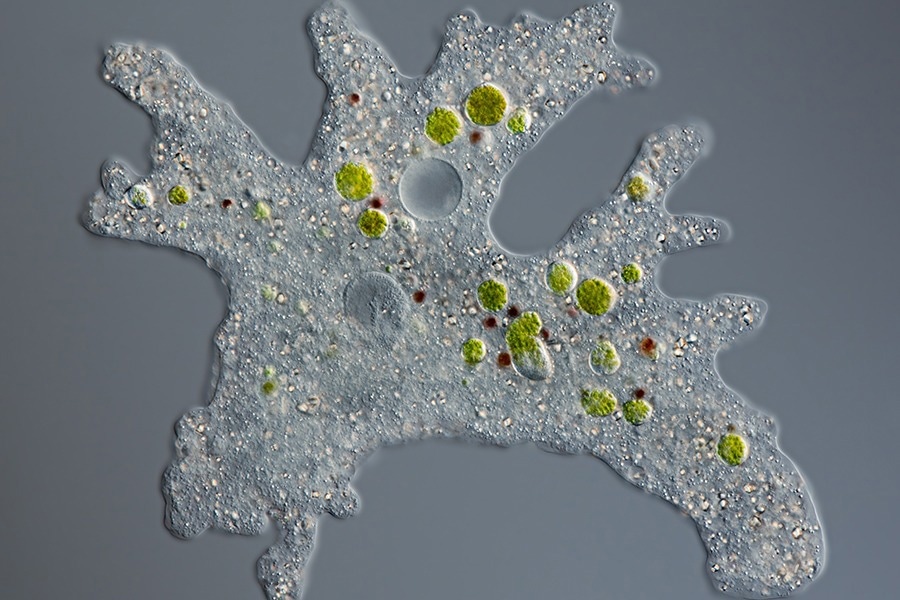Reviewed by Danielle Ellis, B.Sc.Oct 16 2023
Snails, algae, and amoebas all have programmable DNA-cutting enzymes called Fanzors, and a recent study from Massachusetts Institute of Technology’s (MIT) McGovern Institute for Brain Research has found hundreds of them. Fanzors are RNA-guided enzymes that can be programmed to cut DNA at precise locations, similar to the bacterial enzymes that fuel the widely used CRISPR gene-editing system.
 Amoeba proteus. Image Credit: iStock
Amoeba proteus. Image Credit: iStock
The newly identified diversity of natural Fanzor enzymes, which was published on September 27th, 2023 in the journal Science Advances, provides scientists with a large range of programmable enzymes that might be turned into new instruments for study or therapy.
RNA-guided biology is what lets you make programmable tools that are really easy to use. So, the more we can find, the better.”
Omar Abudayyeh, Fellow, McGovern Institute
CRISPR, an ancient bacterial defensive mechanism, has demonstrated the utility of RNA-guided enzymes when converted for use in the lab. Feng Zhang, Abudayyeh, Gootenberg, and others invented CRISPR-based genome editing technologies that have altered the way scientists modify DNA, quickening research and allowing the creation of several experimental gene treatments.
Other RNA-guide enzymes have subsequently been discovered across the bacterial world, many of which have properties that make them useful in the lab. The discovery of Fanzors, whose capacity to cut DNA in an RNA-guided way was revealed earlier this year by Zhang's lab, opens up a new frontier in RNA-guided biology.
Fanzors were the first such enzymes discovered in eukaryotic creatures—a diverse collection of lifeforms characterized by the membrane-bound nucleus that houses each cell’s genetic material. (Bacteria, which lack nuclei, are classified as prokaryotes.)
People have been searching for interesting tools in prokaryotic systems for a long time, and I think that that has been incredibly fruitful. Eukaryotic systems are really just a whole new kind of playground to work in.”
Jonathan Gootenberg, Fellow, McGovern Institute
According to Abudayyeh and Gootenberg, one hope is that enzymes that originated naturally in eukaryotic creatures could be better adapted to work safely and effectively in the cells of other eukaryotic organisms, including humans.
Zhang’s team demonstrated that Fanzor enzymes can be programmed to precisely cut certain DNA regions in human cells. Abudayyeh and Gootenberg observed that certain Fanzors can target DNA sequences in human cells even without the optimization in their latest study.
Gootenberg added, “The fact that they work quite efficiently in mammalian cells was really fantastic to see.”
Hundreds of Fanzors have been discovered among eukaryotic creatures prior to the current investigation. The known variety of these enzymes has now been increased by an order of magnitude by the team of Gootenberg and Abudayyeh, which was led by lab member Justin Lim through a thorough search of genetic databases.
Five distinct families of enzymes could be distinguished among the more than 3,600 Fanzors that scientists discovered in eukaryotes and the viruses that infect them. The specific nature of these enzymes was compared, and they discovered proof of a lengthy evolutionary history.
Fanzors most likely originated from TnpBs, RNA-guided DNA-cutting enzymes found in bacteria. In fact, both Zhang’s team and Gootenberg and Abudayyeh’s team were first interested in the genetic similarities between Fanzors and these bacterial enzymes.
The evolutionary connections discovered by Gootenberg and Abudayyeh imply that the bacterial predecessors of Fanzors likely infiltrated eukaryotic cells more than once, starting their development. Some of these were probably spread by viruses, while others could have been caused by symbiotic bacteria.
The research also implies that the enzymes evolved properties appropriate for their new environment after being incorporated by eukaryotes, such as a signal that permits them to enter a cell nucleus where they have access to DNA.
This promiscuous behavior is absent from Fanzors. They discovered that particular Fanzors were able to cut these target sequences with roughly 10 to 20 percent effectiveness when they utilized an RNA guide to instruct the enzymes to cut specific locations in the genome of human cells.
Abudayyeh and Gootenberg believe that with more study, a range of complex genome editing tools could be created using Fanzors.
“It is a new platform, and they have many capabilities,” Gootenberg noted.
Abudayyeh concluded, “Opening up the whole eukaryotic world to these types of RNA-guided systems is going to give us a lot to work on.”
Source:
Journal reference:
Jiang, K., et al. (2023). Programmable RNA-guided DNA endonucleases are widespread in eukaryotes and their viruses. Science Advances. doi.org/10.1126/sciadv.adk0171